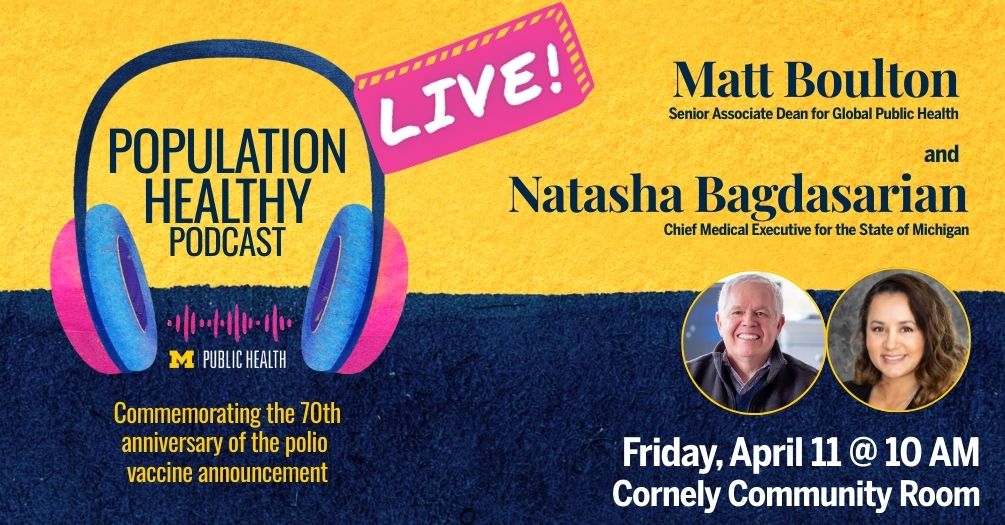Polio vaccine milestone: Live podcast marks 70th anniversary of historic announcement at U-M

U-M epidemiologist Matthew Boulton and Michigan's chief medical executive Natasha Bagdasarian discuss vaccines, then and now
In today's challenging era for vaccines, the University of Michigan School of Public Health will host a live podcast taping April 11 in recognition of the announcement made 70 years ago at U-M, when the polio vaccine was declared safe and effective to a worldwide audience.
After weathering deaths, iron lungs and paralysis primarily of children under 5, a nervous public celebrated the news.
"In factories across the country the PA system would announce that the polio vaccine worked and autoworkers in Detroit and garment workers in New York City wept openly," said historian David Oshinsky, recipient of a Pulitzer Prize for his book, "Polio, an American Story," in an interview for a U-M documentary on the 50th anniversary of the vaccine announcement.
"People sat around radios listening to the results as if it were a Rocky Marciano heavyweight fight. Fire signals went off. Church bells rang."
Natasha Bagadasarian, chief medical executive for the state of Michigan, will join U-M epidemiologist Matthew Boulton for a live recording of the School of Public Health's Population Healthy podcast. They'll discuss the history of the polio vaccine and its development, and explore present-day challenges and trends in using vaccination to protect communities from polio and a wide range of other diseases.
The podcast, free and open to the public, will be recorded live at 10 a.m. before an audience in the Cornely Community Room at U-M's School of Public Health, 1415 Washington Heights, Ann Arbor. Registration is preferred.
The podcast will not be livestreamed, but will be available April 12 on the School of Public Health website and on all major podcast platforms.
The event comes one day before the 70th anniversary of the announcement at U-M's Rackham Auditorium on April 12, 1955, when Dr. Thomas Francis Jr. shared the success of research and testing on Dr. Jonas Salk's vaccine with an unprecedented 1.8 million children in field trials. Francis was chair of epidemiology at the School of Public Health and director of the Poliomyelitis Vaccine Evaluation Center at U-M. Salk did his postgraduate training at U-M's School of Public Health.
Boulton shares his thoughts on the occasion. He is available for advance interviews.
As we reflect on this milestone, what is top of mind for you when it comes to vaccines?
I think there is widespread concern among the public health community that federal funding for immunization programs in the U.S. could be cut. We've made tremendous strides in controlling vaccine preventable disease in this country with greater than 99% reductions in many diseases. However, the recent measles outbreak in Texas involving hundreds of cases, with the majority among unvaccinated children, is testament to how quickly those past successes can unravel if we don't continue to prioritize and invest in childhood vaccination.
How secure are you, or should the public be, in polio remaining an eradicated disease in the United States?
Polio is currently endemic in only two countries, Pakistan and Afghanistan. We've previously come within a hair's breadth of eradicating polio from the world but we're not there yet. That said, we've learned through hard experience that local outbreaks of infectious diseases in distant countries can make their way to the U.S. given the unprecedented and rapid movement of people, animals and products around the world. Recently, there have been staggering cuts to USAID and other international aid organizations that assist countries with vaccination and the detection and control of infectious diseases. We should all be concerned about the implications of those funding cuts for the potential reintroduction of previously eliminated diseases, like polio, to the U.S. I think it represents a very real threat.
How did the public view the arrival of the polio vaccine 70 years ago?
Prior to the development of the Salk polio vaccine in 1955, there were roughly 15,000 to 16,000 cases of paralytic polio in the U.S. every year, and sometimes more. Many parents lived in constant fear of their children contracting the disease, especially in the warm summer months when frequent outbreaks would occur. The arrival of the polio vaccine, and subsequent dramatic reduction in polio cases, was heralded as a historic scientific breakthrough and one of the greatest public health achievements of the 20th century.
Media Contact
Kim North Shine
Senior Public Relations Representative, Health Sciences
Michigan News
[email protected]
313-549-4995
